From: Terry Reilly
Sent: Monday, December 23, 2019 3:09:35 PM (UTC-06:00) Central Time (US & Canada)
Subject: FI Evening Grain Comments 12/23/19
PDF attached includes FI graphs for USDA’s Hogs and Pigs report
CBOT
closes early on Tuesday and will have a hard open Thursday.
CME
Group Holiday Calendar
https://www.cmegroup.com/tools-information/holiday-calendar.html
Traders
will be watching the high-pressure ridge building in Brazil that could yield rain across the dry areas of Argentina if it to shift south.
From
World Weather Inc.
MARKET
WEATHER MENTALITY FOR CORN AND SOYBEANS:
Brazil
and Argentina weather will be favorable over the next two weeks, although the ridge of high pressure in southern Brazil will have to be monitored this week to make sure it is only going to prevail this workweek. If it stays too long there could be a negative
impact on some crops.
Argentina
should see timely rainfall in most of the nation over the next two weeks, although there will still be areas of lighter than desired rainfall. Temperatures will be warm, but not excessively hot. Crops are still stressed in the southwest, despite some recent
rain. More precipitation is needed in all central and southern crop areas.
South
Africa rainfall will be erratic over the next ten days leaving some areas a little too dry while some beneficial crop and field conditions evolve in other areas.
Eastern
Australia’s summer coarse grain and oilseed crops have been stressed in recent heat and dryness, but irrigated areas remain in the best shape. Rain later this week will likely be too close to the coast to benefit very many crops, but some eastern sorghum might
benefit from a little rain this workweek. Temperatures will not be as oppressively hot this week in eastern crop areas.
Winter
rapeseed conditions have not changed much in Europe central Asia of China, but some rain in each of these areas will either improve crop conditions later this week or in the spring when seasonal warming returns.
Late
season harvest progress in the U.S. will only be able to advance slowly in the next couple of weeks. Warm temperatures and limited precipitation through mid-week this week will help some areas. Snow melt and muddy field conditions will not allow much progress,
however.
Overall,
weather today will likely support a mixed influence on market mentality.
MARKET
WEATHER MENTALITY FOR WHEAT AND OTHER SMALL GRAINS:
Winter
wheat conditions in the west-central and southwestern U.S. Plains may improve later this week if the southwestern U.S. storm comes into the Plains as advertised today. The region needs moisture for improved crop establishment in the spring.
Additional
rain in the Midwest later this week will maintain wet field conditions in soft red wheat production areas. Crop conditions will not change much, although rising soil temperatures may reduce winter hardiness as this week moves along especially in the south.
Argentina wheat harvesting will advance relatively well for a while as rainfall continues erratic and light. Last week’s rain briefly disrupted harvest progress, but might have been good for the most immature crops
Turkey and Syria will receive some needed rain this week improving their establishment potential. Most other areas in the Middle East have seen a good mix of weather this season.
Winter
crops in Eastern Europe and the western CIS will not be vulnerable to any winterkill this week as temperatures remain well above average. Snow cover remains minimal
North
Africa wheat is rated favorably, but more rain is needed in southwestern Morocco, Tunisia and some interior eastern Algeria locations.
Recent
rain in Spain and Portugal has improved winter crop prospects for early spring crop development in February. Additional rain would be welcome.
Overall, weather today will likely produce a slightly bearish bias to market mentality.
Source:
World Weather Inc. and FI
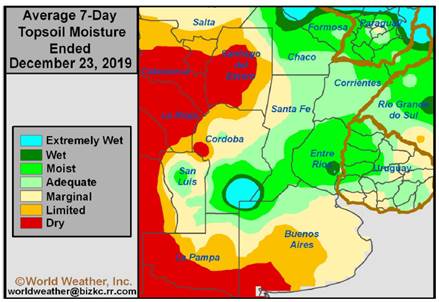
Source:
World Weather Inc. and FI
- USDA
weekly corn, soybean, wheat export inspections, 11am - China
wheat, corn, cotton and sugar imports - USDA
hogs and pig inventories, cold storage, 3pm - EU
weekly grain/oilseed trade data - Ivory
Coast cocoa arrivals
TUESDAY,
Dec. 24:
- Unica
cane crush, sugar production - U.S.
poultry slaughter, 3pm
WEDNESDAY,
Dec. 25:
- Christmas
Day
THURSDAY,
Dec. 26:
- Boxing
Day - AmSpec
releases Malaysia’s Dec. 1-25 palm oil export data, 10pm Monday (11am Kuala Lumpur); SGS data due at 3pm KL
FRIDAY,
Dec. 27:
- USDA
weekly crop net-export sales for corn, soybeans, wheat, 8:30am - EIA
U.S. weekly ethanol inventories, production, 11am - U.S.
agricultural prices paid, received, 3pm - ICE
Futures Europe weekly commitments of traders report on coffee, cocoa, sugar positions ~1:30pm (~6:30pm London)
SATURDAY,
Dec. 28:
- Nothing
major scheduled
SUNDAY,
Dec. 29:
- Nothing
major scheduled
MONDAY,
Dec. 30:
- USDA
weekly corn, soybean, wheat export inspections, 11am - CFTC
commitments of traders weekly report on positions for various U.S. futures and options, 3:30pm
TUESDAY
DECEMBER 31
- AmSpec
releases Malaysia’s Dec. 1-31 palm oil export data, 10pm Monday (11am Kuala Lumpur); SGS data due at 3pm KL
WEDNESDAY,
Jan. 1:
- Nothing
major scheduled
THURSDAY,
Jan. 2:
- Australia
commodity index - USDA
Soybean crush, DDGS production, corn for ethanol, 3pm
FRIDAY,
Jan. 3:
- USDA
weekly crop net-export sales for corn, soybeans, wheat, 8:30am - EIA
U.S. weekly ethanol inventories, production, 11am - ICE
Futures Europe weekly commitments of traders report on coffee, cocoa, sugar positions ~1:30pm (~6:30pm London)
Source:
Bloomberg and FI

USDA
inspections versus Reuters trade range
Wheat
578,458 versus 375000-600000 range
Corn
387,188 versus 500000-700000 range
Soybeans
1,083,866 versus 1000000-1500000 range


·
US Durable Goods Orders (M/M) Nov P: -2.0% (est 1.5%; prev 0.5%)
–
Durables Ex-Transportation (M/M) Nov P: 0.0% (est 0.2%; prev 0.5%)
–
Cap Goods Orders Nondef Ex-Air (M/M) Nov P: 0.1% (est 0.2%; prev 1.1%)
–
Cap Goods Ship Nondef Ex-Air (M/M) Nov P: -0.3% (est 0.0%; prev 0.8%)
·
Canadian GDP (M/M) Oct: -0.1% (est 0.0%; prev 0.1%)
–
GDP (Y/Y) Oct: 1.2% (est 1.4%; prev 1.6%)
·
US New Home Sales Change Nov: 719K (est 730K; prev R 710K)
–
New Home Sales (M/M) Nov: 1.3% (est -0.4%; prev -2.7%)
Corn
·
Corn futures traded 0.75-1.75 cents higher after China indicated they will roll back import tariffs on US goods. Prices eased in the modified session.
·
Funds bought an estimated net 4,000 corn contracts on the session.
·
CBOT March corn during the session traded back above its 100-day MA.
·
Futures volumes were low as the trade enters holiday mode. CH0 versus volume chart below:
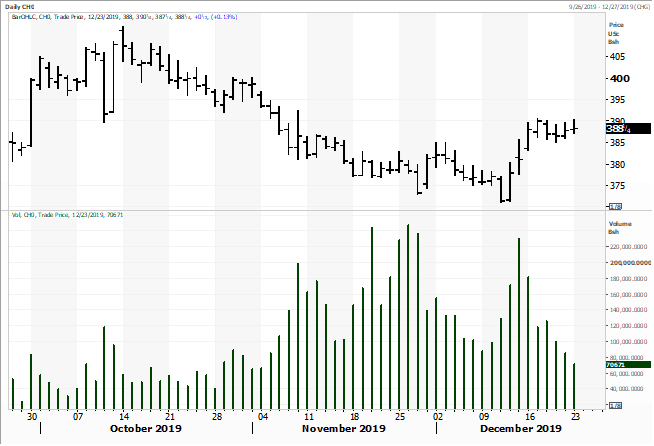
·
USDA US corn export inspections as of December 19, 2019 were 387,188 tons, below a range of trade expectations, below 699,673 tons previous week and compares to 1,014,931 tons year ago. Major countries included
Mexico for 214,126 tons, Japan for 97,760 tons, and Colombia for 16,316 tons.
·
China November pork imports reached 229.707 tons, highest since 2016 and up 150 percent y-o-y. Chicken imports were up 71 percent to 77,895 tons for November (y-o-y). Beef 186,984 tons, up 79 percent.
·
No major surprises were seen this quarter for the USDA hogs and pigs report. All US hogs as of December 1 were 3 percent above a year ago, as expected. Kept for breeding was 2.1 percent higher, a half percentage
point above an average trade guess, and kept for market 3.1 percent above 2018, as expected. The pig crop expansion was less than expected.
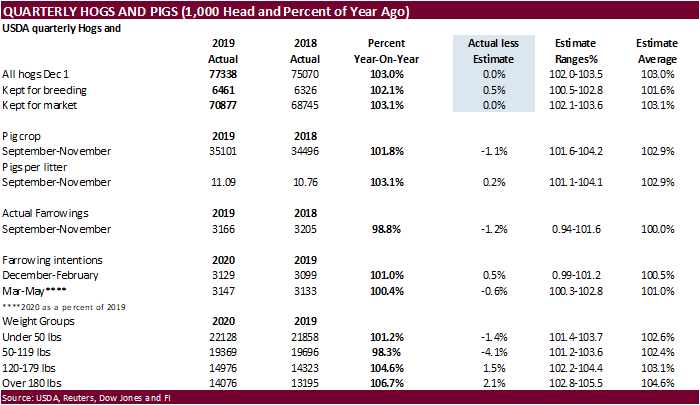
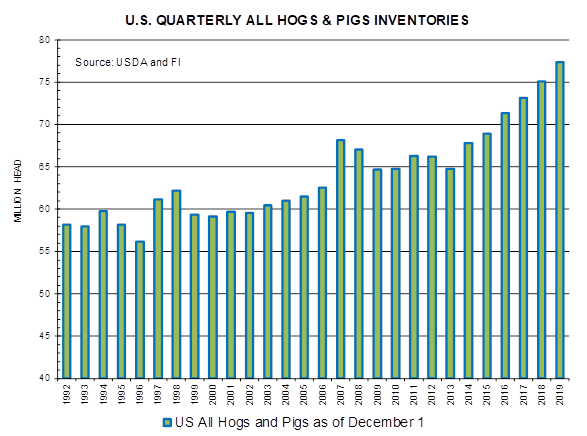
Export
Developments
-
South
Korea seeks 140,000 tons of corn for April 15 arrival. We don’t know as of writing if NOFI bought any corn but hearing Black Sea corn prices are higher than earlier last week. One report said they cancelled.
-
Results
awaited: China will sell 40,000 tons of frozen pork from reserves on December 23.
-
India’s
NAFED seeks 100,000 tons of corn from Ukraine on December 3 with offers valid until December 24 for shipment between Jan. 10 and Jan. 31.
Soybean
complex.
·
CBOT soybeans
traded to a six-week high on hopes China will buy US soybeans after it was reported China will relax on about 390 billion USD of US import tariffs. USDA reported export sales to China this morning, indicating they are still searching for product to fill February
requirements. USDA also reported switches from unknown to other countries, so the trade may have read into this as less soybeans committed to China as some count the “unknown” destination as China. Lighter than expected rains fell across South America over
the weekend. There were 100 CBOT soybean registrations cancelled out of Chicago. We heard soybeans were moving down the Miss down to the Gulf bit not sure if the registration cancellations were connected to it.
·
Funds bought an estimated 6,000 soybeans, bought 3,000 soybean meal and sold 3,000 soybean oil.
·
Bull spreading in soybeans and meal were an early feature. Soybean oil traded slightly as bulls took a pause. Palm oil futures were mostly lower, but cash was up about $2.00. Palm oil prices were up 35 percent
year-to-date earlier this month. We still like owning soybean oil but a short-term correction could be coming up. CBOT crush was higher. The crush has traded in a choppy sideways trading range during the soybean bull run. CBOT meal was up $2.50-3.60/short
ton.
·
There was growing speculation whether or not China could materially buy the amount of agriculture products from the US as stated last week in various reports, but this didn’t seem to affect trading on Monday.
·
USDA US soybean export inspections as of December 19, 2019 were 1,083,866 tons, low end a range of trade expectations, below 1,335,473 tons previous week and compares to 699,629 tons year ago. Soybean shipments
to China slumped to 418k from about 830k previous week. Major countries included China Main for 418,389 tons, Thailand for 89,318 tons, and Mexico for 58,601 tons.
·
Traders will be monitoring the high-pressure ridge over Brazil this week as it could yield beneficial rainfall for Argentina, if the ridge drifts into Argentina during the weekend and next week.
·
Indonesia will be launching B30 mandatory initiative on Jan 1 and Malaysia will be following with B20 in Feb. In late 2018, a 20 percent mandate was enacted.
·
Gapki reported end of October stocks of palm fell 0.5 percent to 3.71 million tons from Sep. and production was 4.52 million tons, down from 4.59 million in September.
·
The European Union reported soybean import licenses since July 1 at 6.614 million tons, below 6.732 million tons a year ago. European Union soybean meal import licenses are running at 9.319 million tons for
2019-20, above 8.095 million tons a year ago. EU palm oil import licenses are running at 2.577 million tons for 2019-20, down from 3.166 million tons a year ago.
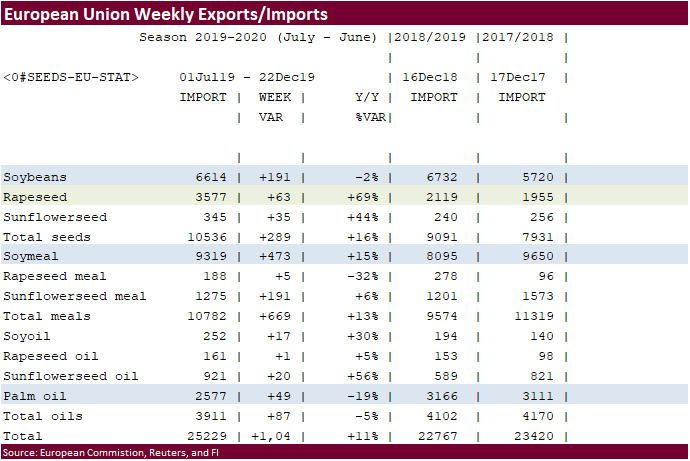
-
Last
Wed. The USDA under the PL-480 program bought 2,000 tons of vegetable oils at $1194.69-$1303.77/ton.
-
Under
the 24-hour reporting system, private exporters reported the sales of 126,000 tons of soybeans for delivery to China during the 2019-20 marketing year and changes in destinations of 220,500 tons of soybeans from unknown destinations to the Netherlands (154,500
metric tons) and Saudi Arabia (66,000 metric tons) during the 2019/2020 marketing year.
CBOT
crush prices traded sideways while soybeans rallied
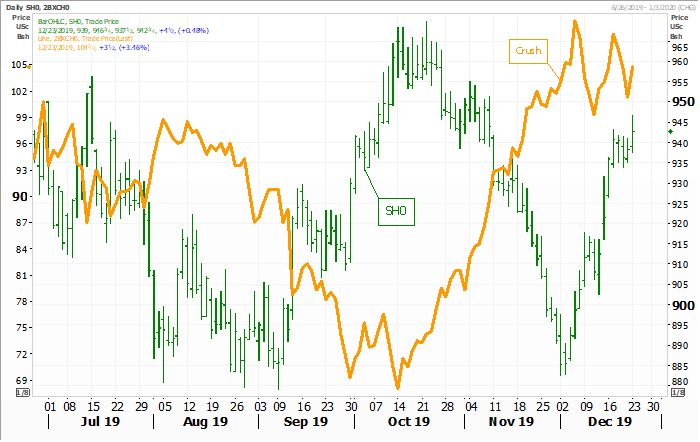
Source:
Refiniv and FI
USDA
released (re-release) a long-term analysis of China soybean origin import market share. Nothing the trade didn’t know but the graph below is a good reminder why US soybean stocks were unusually high at the end of September. With projections for US ending
stocks to decrease over the next 2 to 3 years, we look for soybean prices to appreciate in 2020.
https://www.ers.usda.gov/data-products/chart-gallery/gallery/chart-detail/?chartId=93777

-
CBOT
March soybeans are seen in a $9.00-$9.60 range -
March
soybean meal $295-$315 range -
March
soybean oil 33.00-36.00 range -
Upside
on oil share is seen at 36.5 percent (lowered half percent)
Wheat
·
In a two-sided trade, US wheat futures started higher on technical buying and ended mixed. Chicago saw bear spreading, ending lower in the front months. KC fell 1.75-3.75 cents and MN settled mostly 1.25-1.75
cents higher. Traders are in a wait and see pattern if China decides to buy US wheat. Hot temperatures across Australia and unfavorable European weather continues to support global wheat and gain prices.
·
Chicago wheat prices have averaged $5.34 in December so far, up from $5.16 in November and well up from $4.51 for the April average, the monthly average low for 2019.
·
Through 12/23, the nearby month rolling KC-Chicago wheat spread shattered records. June to date averaged 78 cents, Chicago premium, a record at least from 1980. See the table at the end of this comment.
·
Funds sold an estimated net 2,000 wheat on the session.
·
USDA US all-wheat export inspections as of December 19, 2019 were 578,458 tons, within a range of trade expectations, above 510,183 tons previous week and compares to 578,794 tons year ago. Major countries
included Mexico for 127,821 tons, Philippines for 101,398 tons, and Bangladesh for 64,172 tons.
·
Russian wheat export prices appreciated for the sixth straight week. 12.5% protein wheat was up a large $6.00/ton to $216/ton fob as of late last week, according to IKAR. SovEcon reported a $3.00/ton increase
to $216/ton.
·
Taiwan plans to buy more agriculture goods, likely from the US, as their trade surplus widens.
·
News was light.
·
A winter storm is expected in the U.S. central and southwestern Plains late this week and into the weekend.
·
March Paris wheat futures settled up 0.75 euro or 0.3% at 187.00 euros a ton.
·
The European Union granted export licenses for 152,000 tons of soft wheat imports, bringing cumulative 2019-20 soft wheat export commitments to 13.402 MMT, up from 8.015 million tons committed at this time
last year, a 38 percent increase. Imports are down 48 percent from year ago at 2.302 million tons.
c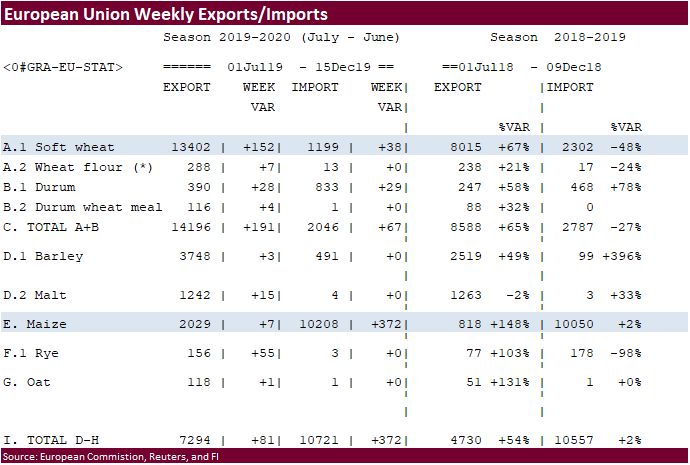
Russian
grain exports for the first six months of the year are slow.

Export
Developments.
- Japan’s
Ministry of Agriculture, Forestry and Fisheries (MAFF) in an SBS import tender on December 25 seeks 120,000 tons of feed wheat and 200,000 tons of feed barley for arrival in Japan by March 12.
- Mauritius
seeks 95,000 tons of optional origin wheat flour on Jan. 10, 2020, for shipment between July 1, 2020, and June 20, 2021.
·
Syria seeks 200,000 tons of soft wheat from Russia on January 20, 2020. They are in for 150,000 tons of wheat from Russia on December 18.
Rice/Other
Details
of the tender are as follows:
TONNES(M/T) GRAIN TYPE ARRIVAL/PORT
3,000 Milled Long April 30, 2020/Busan
17,000 Milled Medium June 30, 2020/Busan
22,222 Brown Medium June 30, 2020/Busan
- Syria
seeks 45,000 tons of white rice on Jan. 6, 2020. (Reuters) Short grain white rice of third or fourth class was sought. No specific country of origin was specified in the tender, traders said. Some 25,000 tons was sought for supply 90 days after confirmation
of the order and 20,000 tons 180 days after supply of the first consignment. The rice was sought packed in bags and offers should be submitted in euros. A previous tender from the agency for 45,000 tons of rice with similar conditions had closed on Nov.
13.
Updated
12/17/19
·
CBOT Chicago March wheat is seen in a $5.30-$5.80 range
·
CBOT KC March wheat is seen in a $4.60-$4.85 range
·
MN March wheat is seen in a $5.25-$5.55 range
·
We like KC wheat over Chicago wheat.
Terry Reilly
Senior Commodity Analyst – Grain and Oilseeds
Futures International │190 S LaSalle St., Suite 410│Chicago, IL 60603
W: 312.604.1366
AIM: fi_treilly
ICE IM:
treilly1
Skype: fi.treilly

Trading of futures, options, swaps and other derivatives is risky and is not suitable for all persons. All of these investment products are leveraged, and you can lose more than your initial deposit. Each investment product is offered
only to and from jurisdictions where solicitation and sale are lawful, and in accordance with applicable laws and regulations in such jurisdiction. The information provided here should not be relied upon as a substitute for independent research before making
your investment decisions. Futures International, LLC is merely providing this information for your general information and the information does not take into account any particular individual’s investment objectives, financial situation, or needs. All investors
should obtain advice based on their unique situation before making any investment decision. The contents of this communication and any attachments are for informational purposes only and under no circumstances should they be construed as an offer to buy or
sell, or a solicitation to buy or sell any future, option, swap or other derivative. The sources for the information and any opinions in this communication are believed to be reliable, but Futures International, LLC does not warrant or guarantee the accuracy
of such information or opinions. Futures International, LLC and its principals and employees may take positions different from any positions described in this communication. Past results are not necessarily indicative of future results.
This email, any information contained herein and any files transmitted with it (collectively, the Material) are the sole property of OTC Global Holdings LP and its affiliates (OTCGH); are confidential, may be legally privileged and are intended solely for
the use of the individual or entity to whom they are addressed. Unauthorized disclosure, copying or distribution of the Material, is strictly prohibited and the recipient shall not redistribute the Material in any form to a third party. Please notify the sender
immediately by email if you have received this email by mistake, delete this email from your system and destroy any hard copies. OTCGH waives no privilege or confidentiality due to any mistaken transmission of this email.
